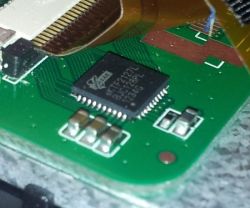Impressions from FOSDEM 2014
Written by Paul Kocialkowski no commentsWell, this is mostly going to be about my experience at FOSDEM 2014. Thanks to being a student in a city that features an easy-to-access airport, I was able to attend this year's edition. While my travel schedule was real tight, I only found out the plane was landing not in Brussels, but in Charleroi a few days before departure. Thankfully, it wasn't too late to find another schedule that made it possible for me to arrive at the Friday Beer event around dinner time. The cafe, and the aisle that leads to it were incredibly crowded, to the point that it was barely even possible to make it to the entrance. And once there, despite the fact that the cafe had been reserved for FOSDEM attendees only, I sadly couldn't get in, since the interior of the cafe was apparently full as well. While waiting near the entrance, I was able to see Greg K.H., first of the numerous giants of the free software community I stumbled upon at FOSDEM.
The next day, I was really amazed to see so many people going to FOSDEM, on the way to the event. Public transportation was really filled up with free software hacktivists! Arriving at the ULB campus used for FOSDEM, it really felt spacious and seemed appropriate for an event that big. Lots of interesting discussions took place after the first talk I attended: it was really nice. There were also numerous stands, mostly divided in two buildings, with many interesting people to talk to as well. In the AW building, I enjoyed the Coreboot/Flashrom stand (free software BIOS), Hackable-Devices (apparently focusing on micro-controlers recently), OlinuXino (Allwinner single board computers) and OpenPandora (free software gaming device) with a prototype of the new OMAP5-based version of the device, running apparently really well on GNU/Linux without graphics acceleration blobs. However, the big slice of stands was in the K building, including popular GNU/Linux distros such as Debian or Fedora and desktop environments such as GNOME and KDE. The FSFE was also there, with real good-looking flyers about their Free Your Android campaign, promoting Replicant and F-Droid! I also spent some time at the CaCert booth, and frankly, I was amazed by the depth of the identity verification process. First off, having a single official document to prove of your identity is not enough for these guys, and things get worse when the signature on the ID card (kindly provided by mom at a time I couldn't sign it for myselef) doesn't match the one you produce. Not to mention you have to sign the paper before their eyes, else it's not valid. The ID card itself is also checked to be genuine, with the many UV lights at their disposal and descriptions of the expected results. So I was really surprised how strict the whole process is and I think it's really great that they are taking this very seriously.
The rest of the afternoon we spent in the legal devroom, where I could meet many great people such as John Sullivan, Bradley Kuhn, Karen Sandler and others. John gave a talk about Javascript, with all relevant infos regarding how to escape the Javascript trap, followed by Chris Webber about free network services and introducing the road map for the next MediaGoblin releases, with a really good-looking video explaining the goals. Chris was probably the most enthusiastic speaker I saw at FOSDEM: he was really passionate about his talk and created a wonderful ambiance in the room (summoning that feeling that urges you to get involved in something bigger than you), so kudos to him for being that good. After a while, we headed to dinner with the Coreboot crew, very nice and interesting people. It was a real pleasure spending time in their company.
On Sunday, we had to rush to get to FOSDEM in time for the F-Droid track by Daniel Martí, followed by an introduction to the linux-sunxi community by Olliver Schinagl, who kindly poked the Replicant project during the talk mentioning that I've been promising Replicant for Allwinner devices for the last six months. Olliver's talk really made me realize what an amazing platform Allwinner is, so I just went ahead and ordered a variety of Allwinner devices to port Replicant to, so we should get there in the near future! On the way to lunch, I quickly saw someone I believe to have been Harald Welte: while I would have loved to have thanked him for his great work, he went by faster than it took me to realize who he was. Time went by, and in the afternoon, I could only attend the Lima talk by Luc Verhaegen before leaving. The project is apparently steadily moving forward, however, without any mind-blowing demo this time. I really had to leave fast after the talk, to catch up with my transportation schedule.
I really have the best memories from FOSDEM, it was really nice and there is no doubt I'll attend next year's edition, hopefully presenting a talk about Replicant there. It was also really nice to see people grateful for the work I'm doing on Replicant. Such huge community gatherings are the best to gather the motivation to keep working on a free software project: actually meeting the community brings a whole different picture compared to what contributing to free software usually feels like individually, hacking alone in my dark room.
